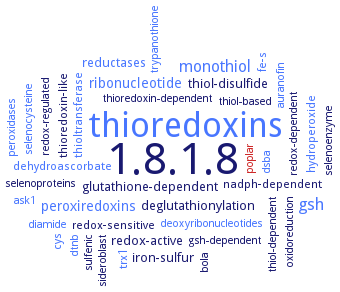1.8.1.8: protein-disulfide reductase
This is an abbreviated version!
For detailed information about protein-disulfide reductase, go to the full flat file.

Word Map on EC 1.8.1.8 
-
1.8.1.8
-
thioredoxins
-
gsh
-
monothiol
-
ribonucleotide
-
peroxiredoxins
-
deglutathionylation
-
glutathione-dependent
-
redox-active
-
reductases
-
thiol-disulfide
-
iron-sulfur
-
fe-s
-
redox-sensitive
-
thioltransferase
-
trx1
-
thioredoxin-like
-
dehydroascorbate
-
nadph-dependent
-
cys
-
hydroperoxide
-
deoxyribonucleotides
-
selenoenzyme
-
auranofin
-
bola
-
thioredoxin-dependent
-
redox-dependent
-
selenocysteine
-
gsh-dependent
-
trypanothione
-
thiol-based
-
diamide
-
oxidoreduction
-
dtnb
-
peroxidases
-
redox-regulated
-
sulfenic
-
dsba
-
ask1
-
poplar
-
selenoproteins
-
sideroblast
-
thiol-dependent
- 1.8.1.8
- thioredoxins
- gsh
- monothiol
- ribonucleotide
- peroxiredoxins
-
deglutathionylation
-
glutathione-dependent
-
redox-active
- reductases
-
thiol-disulfide
-
iron-sulfur
- fe-s
-
redox-sensitive
- thioltransferase
- trx1
-
thioredoxin-like
- dehydroascorbate
-
nadph-dependent
- cys
- hydroperoxide
- deoxyribonucleotides
-
selenoenzyme
- auranofin
-
bola
-
thioredoxin-dependent
-
redox-dependent
- selenocysteine
-
gsh-dependent
- trypanothione
-
thiol-based
- diamide
-
oxidoreduction
- dtnb
- peroxidases
-
redox-regulated
-
sulfenic
- dsba
- ask1
- poplar
-
selenoproteins
-
sideroblast
-
thiol-dependent
Reaction
Synonyms
AhpF, disulfide reductase, EC 1.6.4.4, ERdj5, ERp16, glutaredoxin, HvTrxh2, insulin-glutathione transhydrogenase, LpdA, MA3736, MA_1658, MdrA, methanoredoxin, More, NAD(P)H:protein-disulfide oxidoreductase, NADH-linked disulfide reductase, panthethine 4'4-diphosphate-specific reductase, PDI reductase, PDO, PfPDO, PH1130 protein, PhDsb, protein disulfide isomerase reductase, protein disulfide oxidoreductase, protein disulfide reductase, protein-disulfide oxidoreductase, protein-disulfide reductase (NAD(P)H), reductase, protein disulfide, thiol-disulfide oxidoreductase, TON_0319, TTC0486, WhiB1, WhiB1/Rv3219


 results (
results ( results (
results ( top
top






